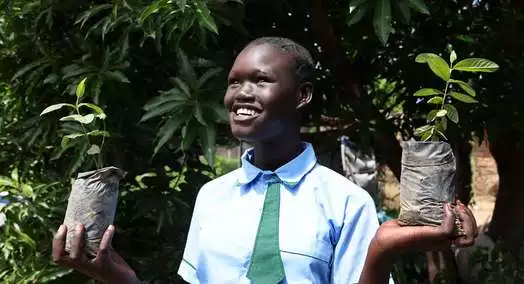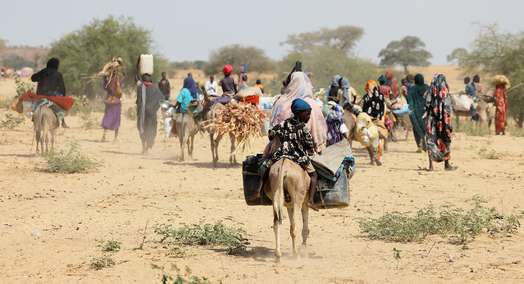
Reconstruction after the Earthquake
At a strength of 7.9 and 7.4 respectively, the earthquakes of April 25th and May 12th, 2015, were the deadliest disaster in the history of Nepal. According to the government, some 9,000 people died as a result of the quakes and approximately 22,300 were injured. Nationwide, 600,000 houses lay in ruins. In Gorkha and Sindhupalchok, the epicentres of the earthquakes, almost 90% of the infrastructure and homes were destroyed.
Since the two great earthquakes of 2015, Welthungerhilfe has reached more than 155,000 people with emergency aid measures. In 2017, that number is expected to rise by over 35,000. This includes distributing food, offering medical care, providing water supplies and establishing emergency shelters. However, aside from the numerous long-term projects for the improvement of the food and nutrition situation and of disaster prevention, the halting progress of rehabilitation continues to be one of the greatest problems on the ground.

Many of the factors that were already hindering rehabilitation a year ago persist today. Due to the partially very difficult terrain in Nepal, the identification and registration process for earthquake victims extended into late April 2016. Complicated bureaucratic processes significantly slowed down the start of reconstruction efforts, since the National Reconstruction Authority (NRA) only developed new construction standards for earthquake-safe houses at a late date and did not issue any building permits before then.
Other difficulties during reconstruction are completely practical in nature. Local construction materials were and are scarce, as are trained workers. Often, only the elderly, women and children remain in the villages. The bulk of young men who are fit to work have left the country in recent years in order to earn money in Dubai, Malaysia and Saudi Arabia.
However, there is light at the end of the tunnel. The government is hiring more engineers and investing in professional training programmes for masons and carpenters. In addition, international aid organisations can now directly provide funds to rebuild houses.
However, damaged houses are not the only focus. A quarter of the Nepalese population lives under the national poverty line of USD 0.50 per day, and 35% of the population does not enjoy good food and nutrition security.
How Welthungerhilfe Supports People in Nepal
Improving the food and nutrition situation: Disseminating more efficient agricultural cultivation methods and diversifying seeds and yields. These measures help to combat the widespread effects of unbalanced nutrition and malnutrition. Approximately 41% of Nepalese children under five years of age are too small for their age, 29% are underweight and 11% suffer from acute malnutrition. In addition to the improvements of the food and nutrition situation, these measures also permit the sale of surplus goods.
-
Disaster prevention: Improving emergency preparedness and efficient reaction processes on the local level (Joint Emergency Preparedness Plan (JEPP)) for faster responses in emergency situations.
-
Resilience: Vulnerable households receive support with accumulating reserves for times of disaster and scarcity in order to better protect themselves from food shortages and environmental disasters.
-
Access to microcredit: Out of frustration with long construction waiting periods for private and public buildings, many people and communities borrowed money at exorbitant interest rates. However, trying to handle rehabilitation efforts themselves left many Nepalese ruined and in poverty. Easier access to microcredit will improve this situation.
-
WASH projects: Improving water supply and hygiene education about drinking water. Learn more here.
There is Still Much to Do: Reconstruction and Disaster Risk Reduction
However, there is still much to be done: Political measures remain unclear; in some places, reconstruction is proceeding at a glacial pace. The construction of a school in the district Dhading is still in full swing.
In the future, the focus of our work in Nepal will be on food and nutrition security, the strengthening of the right to food, and on disaster risk reduction: Welthungerhilfe will remain by the side of the people of Nepal and intends to strengthen people and communities in the long term. However, both poverty and hunger continue to exist, and the danger of further earthquakes, landslides and floods remains.
Many people from Germany showed solidarity with the earthquake victims and gave donations in support. Prominent individuals and corporate partners also generously supported our emergency aid efforts and sent out appeals: Jay Alexander, Yvonne Catterfeld, Till Demtrøder, Janina Hartwig, Claudia Jung, Michaela May, Minh-Khai Phan-Thi, Christian Rach and Bärbel Schäfer, as well as corporate donations, actions and employee contributions from the company Myboshi (Thomas Jaenisch and Felix Rohland), der Tagesspiegel, CANUSA Tourism and OTTO.
Our volunteers and action groups were a big help with creative events and actions: the action groups Leer, Bekond Aktiv e.V., Lohrer Hausfrauen, Sonja Huber, Paul Schömbs in conjunction with his wife from Nepal, Egbert Lewark of the band Splendid Brass and the artist HP Wank.
Many thanks to all the supporters!







